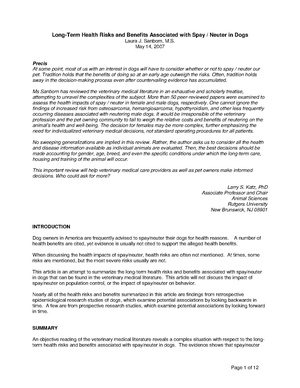Long-Term Health Risks and Benefits Associated with Spay / Neuter in Dogs
Author Laura J. Sanborn, M.S.

May 14, 2007
Abstract
At some point, most of us with an interest in dogs will have to consider whether or not to spay / neuter our
pet. Tradition holds that the benefits of doing so at an early age outweigh the risks.
Often, tradition holds sway in the decision-making process even after countervailing evidence has accumulated.
Ms. Sanborn has reviewed the veterinary medical literature in an exhaustive and scholarly treatise, attempting to unravel the complexities of the subject. More than 50 peer-reviewed papers were examined to assess the health impacts of spay / neuter in female and male dogs, respectively. One cannot ignore the findings of increased risk from osteosarcoma, hemangiosarcoma, hypothyroidism, and other less frequently occurring diseases associated with neutering male dogs.
It would be irresponsible of the veterinary profession and the pet owning community to fail to weigh the relative costs and benefits of neutering on the animal’s health and well-being. The decision for females may be more complex, further emphasizing the need for individualized veterinary medical decisions, not standard operating procedures for all patients.
No sweeping generalizations are implied in this review.
Rather, the author asks us to consider all the health and disease information available as individual animals are evaluated. Then, the best decisions should be made accounting for gender, age, breed, and even the specific conditions under which the long-term care, housing and training of the animal will occur.
This important review will help veterinary medical care providers as well as pet owners make informed
decisions. Who could ask for more?
Larry S. Katz, PhD
Associate Professor and Chair
Animal Sciences
Rutgers University
New Brunswick, NJ 08901